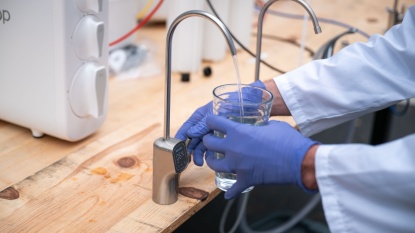Aluminum Exposure Alters Key Metabolites in Entomoneis – Bioengineer.org

Report on the Ecological Impact of Aluminum Exposure on Diatoms in the Context of Sustainable Development Goals
1.0 Executive Summary
A recent study by Ragunathan, Purdy, and Seppala (2025) investigates the metabolic impact of increased aluminum exposure on the diatom species Entomoneis vertebralis. The findings reveal significant disruptions to silicon, carbon, and nitrogen metabolism, presenting critical challenges to several United Nations Sustainable Development Goals (SDGs), particularly SDG 14 (Life Below Water), SDG 6 (Clean Water and Sanitation), and SDG 13 (Climate Action). This report analyzes the study’s implications for ecosystem health and outlines its relevance to global sustainability targets.
2.0 Research Findings and Metabolic Disruptions
The study provides empirical evidence of widespread metabolic changes in a keystone aquatic species due to aluminum contamination, a byproduct of anthropogenic activities such as mining and industrial processes.
2.1 Key Metabolic Pathways Affected
- Silicon Metabolism: Aluminum exposure was found to disrupt silicon assimilation. This directly impairs the diatom’s ability to form its silica frustule (shell), which is essential for structural integrity, growth, and reproduction.
- Carbon Metabolism: Researchers observed altered carbon allocation, suggesting reduced photosynthetic efficiency. This impairment of carbon fixation by a primary producer has cascading effects on aquatic food webs and global carbon cycles.
- Nitrogen Metabolism: The study indicated that aluminum interferes with nitrogen uptake and assimilation pathways. This can lead to nutrient imbalances, affecting the growth of diatoms and the stability of the ecosystems that depend on them.
3.0 Alignment with Sustainable Development Goals (SDGs)
The research findings directly inform and underscore the urgency of achieving several SDGs by highlighting the vulnerability of foundational aquatic species to industrial pollution.
3.1 SDG 14: Life Below Water
The health of Entomoneis vertebralis is integral to marine and freshwater ecosystems. The study’s conclusions are critically relevant to Target 14.1, which aims to prevent and significantly reduce marine pollution of all kinds.
- Ecosystem Health: As a keystone species, the decline of diatoms due to aluminum toxicity threatens the stability of the entire aquatic food web.
- Biodiversity: The inability of diatoms to reproduce and grow effectively contributes to a loss of biodiversity, undermining the resilience of aquatic habitats.
3.2 SDG 6: Clean Water and Sanitation
The research emphasizes the threat of chemical contamination in water bodies, a core concern of SDG 6. The increasing concentration of aluminum from human activities directly degrades water quality, impacting aquatic life.
- Water Quality Monitoring: The findings advocate for enhanced monitoring of aluminum levels in water systems, aligning with Target 6.3 to improve water quality by reducing pollution.
- Pollution Mitigation: The study implicitly calls for policies to regulate the release of aluminum from industrial sources into aquatic environments.
3.3 SDG 13: Climate Action and SDG 12: Responsible Consumption and Production
The disruption of diatom carbon metabolism has direct implications for global climate regulation, while the source of the pollution points to unsustainable production patterns.
- Climate Regulation (SDG 13): Diatoms are vital for the oceanic biological carbon pump. Reduced carbon fixation capacity in these organisms weakens a critical natural carbon sink, exacerbating climate change challenges.
- Sustainable Industry (SDG 12): The study links aluminum pollution to industrial and mining activities, highlighting the need for the environmentally sound management of chemicals and wastes (Target 12.4) to protect human health and the environment.
4.0 Methodological Innovation and Future Research
The study utilized advanced genomic and biochemical techniques to provide a molecular-level understanding of aluminum’s impact. This innovative approach supports SDG 9 (Industry, Innovation, and Infrastructure) by advancing scientific research capabilities (Target 9.5).
4.1 Recommendations for Future Action
- Policy Integration: Environmental policies must incorporate regulations to limit aluminum discharge from industrial and agricultural sources.
- Interdisciplinary Research: Further collaboration between ecologists, chemists, and policymakers is required to understand and mitigate the broader biogeochemical consequences of metal contamination.
- Enhanced Monitoring: A proactive approach to monitoring aluminum levels in vulnerable aquatic ecosystems is essential for early intervention and the protection of foundational species.
5.0 Conclusion
The research by Ragunathan et al. provides a stark warning about the consequences of unchecked aluminum pollution on vital aquatic microorganisms. The disruption of fundamental metabolic processes in Entomoneis vertebralis threatens not only aquatic biodiversity (SDG 14) but also water quality (SDG 6) and global carbon cycles (SDG 13). Addressing this challenge requires a concerted effort to promote sustainable industrial practices (SDG 12) and translate scientific findings into robust environmental protection policies to safeguard planetary health for future generations.
Analysis of Sustainable Development Goals in the Article
1. Which SDGs are addressed or connected to the issues highlighted in the article?
-
SDG 6: Clean Water and Sanitation
The article directly addresses this goal by focusing on the contamination of aquatic ecosystems with aluminum. It highlights that the “alarming rise of aluminum levels in various natural habitats” is due to human activities like mining and industrial processes, which degrade water quality and impact aquatic life.
-
SDG 12: Responsible Consumption and Production
This goal is connected through the source of the pollution. The article identifies “mining, industrial processes, and the application of aluminum-containing products” as the cause of increased aluminum levels. The call for “regulations that mitigate aluminum release into water systems” points towards the need for more sustainable production patterns to manage chemicals and waste responsibly.
-
SDG 13: Climate Action
The article explicitly links its findings to climate change, stating that the research “contributes significantly to the broader discourse on climate change and environmental degradation.” It discusses how pollution acts as a combined stressor with rising global temperatures and notes that disruption to diatoms’ carbon metabolism “raises alarms about potential impacts on global carbon cycles.”
-
SDG 14: Life Below Water
This is the most central SDG to the article. The entire study revolves around the adverse effects of aluminum pollution on a keystone aquatic diatom species, Entomoneis vertebralis. The research details how this pollution disrupts metabolic pathways, threatening the health of the diatoms and, by extension, the stability of “aquatic food webs” and the overall health of marine and freshwater ecosystems.
-
SDG 15: Life on Land
While the primary focus is on aquatic life, SDG 15 is relevant as the pollution originates from land-based activities like “mining” and “industrial processes.” The article also mentions the impact on “freshwater ecosystems,” which are a key component of this goal, and discusses the degradation of natural habitats and loss of biodiversity due to contamination.
2. What specific targets under those SDGs can be identified based on the article’s content?
-
Target 6.3: Improve water quality by reducing pollution.
The article’s core subject is the pollution of water by aluminum from anthropogenic sources. The call for “increased monitoring of aluminum levels in aquatic ecosystems” and “regulations that mitigate aluminum release” directly supports the aim of reducing pollution and improving water quality.
-
Target 12.4: Environmentally sound management of chemicals and all wastes.
The article identifies aluminum as a contaminant released from “industrial processes.” The recommendation for policies to control this release aligns with achieving the environmentally sound management of chemical pollutants to minimize their adverse impacts on the environment.
-
Target 14.1: Prevent and significantly reduce marine pollution of all kinds, in particular from land-based activities.
The research directly addresses this target by investigating a form of chemical pollution (aluminum) originating from land-based human activities (mining, industry) that negatively impacts aquatic ecosystems.
-
Target 14.2: Sustainably manage and protect marine and coastal ecosystems to avoid significant adverse impacts.
The study emphasizes the need to protect foundational species like diatoms to ensure ecosystem health. By detailing how aluminum exposure disrupts key metabolic functions, the article underscores the vulnerability of these ecosystems and the need for protective measures to maintain their resilience and function.
-
Target 15.5: Take urgent and significant action to reduce the degradation of natural habitats and halt the loss of biodiversity.
The article highlights that aluminum pollution poses a threat to Entomoneis vertebralis, a “keystone species.” The disruption of its growth and reproduction could lead to cascading effects, contributing to the degradation of its habitat and a loss of biodiversity within the aquatic food web.
3. Are there any indicators mentioned or implied in the article that can be used to measure progress towards the identified targets?
-
Implied Indicator: Concentration of aluminum in aquatic ecosystems.
The article explicitly advocates for “increased monitoring of aluminum levels in aquatic ecosystems.” This measurement would serve as a direct indicator for tracking progress on reducing pollution, relevant to Targets 6.3, 12.4, and 14.1.
-
Implied Indicator: Health and reproductive capacity of keystone aquatic species.
The study’s focus on the “disrupted silicon assimilation” affecting the “structural integrity and reproductive capacity” of diatoms implies that the population health, density, and reproductive success of species like Entomoneis vertebralis can be used as a bio-indicator to measure ecosystem health and the effectiveness of protection measures (Targets 14.2 and 15.5).
-
Implied Indicator: Rate of carbon fixation by primary producers in aquatic ecosystems.
The research highlights a “reduced efficiency in photosynthesis and energy conversion” and “reduced carbon fixation” in diatoms due to aluminum exposure. Measuring the rate of carbon fixation in these ecosystems can therefore serve as an indicator of the impact of pollution on fundamental ecosystem processes, relevant to Targets 13 and 14.2.
-
Implied Indicator: Status of nutrient cycling processes (silicon, nitrogen).
The study’s detailed analysis of “disrupted silicon assimilation” and disrupted “nitrogen uptake and assimilation pathways” suggests that monitoring the levels and cycling of these key nutrients in water bodies can indicate the functional integrity of the ecosystem and the impact of pollutants.
4. Table of SDGs, Targets, and Indicators
| SDGs | Targets | Indicators (Implied from the Article) |
|---|---|---|
| SDG 6: Clean Water and Sanitation | Target 6.3: By 2030, improve water quality by reducing pollution. | Concentration of aluminum and other heavy metals in water bodies. |
| SDG 12: Responsible Consumption and Production | Target 12.4: Achieve the environmentally sound management of chemicals and all wastes. | Volume of untreated industrial effluent containing aluminum released into water systems. |
| SDG 13: Climate Action | Target 13.3: Improve education and awareness-raising on climate change impact reduction. | Rate of carbon fixation by aquatic primary producers (e.g., diatoms) as a measure of ecosystem impact on the global carbon cycle. |
| SDG 14: Life Below Water | Target 14.1: Prevent and significantly reduce marine pollution of all kinds from land-based activities.
Target 14.2: Sustainably manage and protect marine and coastal ecosystems. |
Population health, density, and reproductive success of keystone species like diatoms.
Functional integrity of metabolic pathways (silicon, carbon, nitrogen) in foundational aquatic organisms. |
| SDG 15: Life on Land | Target 15.5: Reduce the degradation of natural habitats and halt the loss of biodiversity. | Biodiversity indices in freshwater ecosystems affected by land-based pollution. |
Source: bioengineer.org

What is Your Reaction?
 Like
0
Like
0
 Dislike
0
Dislike
0
 Love
0
Love
0
 Funny
0
Funny
0
 Angry
0
Angry
0
 Sad
0
Sad
0
 Wow
0
Wow
0



















































.jpg.webp?itok=0ZsAnae9#)

























